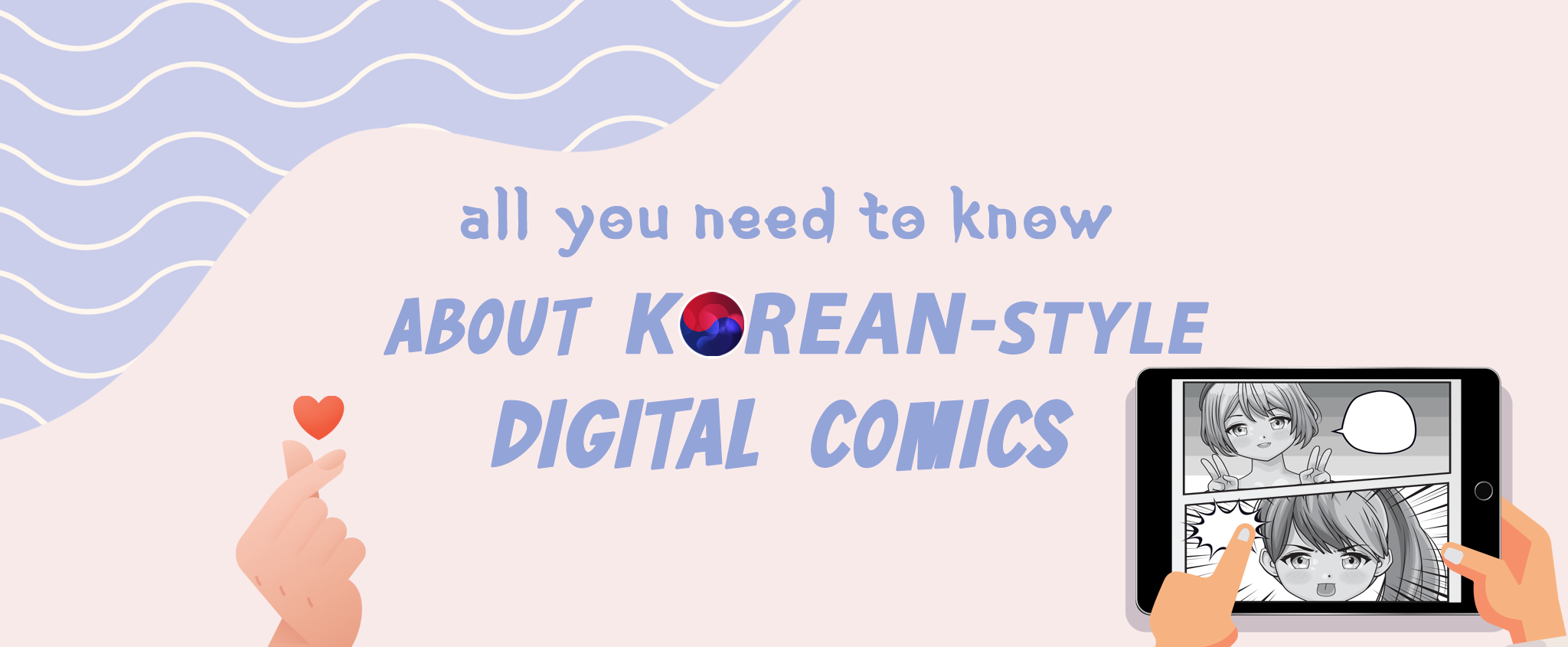All You Need to Know about Korean-style Digital Comics
Key takeaways:
- Korean-style digital comics draw attention to audiences worldwide, optimizing mobile-friendly design, convenience, and uniqueness.
- Korean webtoons have gone through changes over the years. Still, they keep up with the market with the standard that local and global readers recognize.
- The Korean digital comics market is continuously growing, exceeding 1 trillion won in 2021, and is forecasted to reach $26,214 million by 2028.
- Webtoons have become increasingly popular in Asian countries, particularly in Taiwan, Vietnam, Malaysia, and Indonesia.
- Webtoons are gathering more young readers. 61% of the webtoon audience in Taiwan is under 24.
- Working with a professional comics translator allows creators and producers to make titles available in many languages without affecting the overall quality of the comics.
- As more people discover the incomparable entertainment brought by Korean digital comics, more creators and companies rely on webtoon translation, localization, and typesetting.
Table of contents
- The Globalization Processes of Korean Digital Comics
- Korean Digital Comics Revolution
- CCCI – Professional Korean Digital Comics Services
It doesn’t matter where you are in the world; if you are an avid fan of comics, exploring all types of comics, genres, and styles is an excellent way to grow. And if you have not explored it yet, Korean-style digital comics have some of the world’s most popular titles!
Naver Webtoon and Kakao Webtoon are only two of the multiple webtoon services that have launched platforms in various countries to allow foreign readers to access the best Korean digital comics. In 2021, more than 40% of the respondents of a survey stated that webtoons were very popular, proving that the South Korean webtoon market is continuously growing, reaching even the international audience.
In this article, let us get a deeper understanding of Korean digital and online comics. How did they start? How big is the global market? And what is its future? Let us find out!
The Globalization Processes of Korean Digital Comics
One of the most well-known Korean webtoonists, Tae-ho Yoon said, “Nobody knows what point we’re at in the history of webtoons right now, but I thought it was time to explore all the possibilities.” This was in 2014 when 15 Korean webtoon creators formed the cooperative group Toonion. Webtoons are still developing in keeping with global and technological conditions, but they have definitely made a significant impact on the Korean comics industry. Webtoons have also contributed to comics globalization, which was previously limited to Japanese manga and American comics.
Korean-style digital comics started in the late 1990s. The public gained access to personal web pages, all thanks to the development of information technologies. Cartoonists and illustrators distributed their character-based cartoon essays through personal web pages or blogs. They generated revenue through book publications and related merchandise.
Note: “Webtoon,” a combination of “web” and “cartoon,” was first used in the Korean comics industry in 2000. However, the term only gained widespread recognition in the country in the mid-2000s. Major Korean web portals competitively started free webtoon services in 2002, generating more traffic and gathering more active users.
Eventually, some successful webtoons were repackaged into television shows and movies. The original stories that webtoons provided the audience built fan bases. Filmmakers and producers optimized the colorful visuals, making webtoons a crucial part of the Korean entertainment industry.
Webtoons developed through time, establishing an industrial standard that the world now recognizes. They have gone through various changes over the decades, but they have unique characteristics recognized domestically and globally.
Webtoons are closely related to manhwa, which are made in Korea. Manhwa from South Korea is available to the public, including English-speaking readers. Now, webtoons are generally animated cartoons published on the Internet. Stories are told in long and vertical with panels arranged for continual scrolling. They are made for digital reading, so they are mostly in full color.
Technology played an essential role in the birth and growth of Korean-style digital comics, but what pushed it to reach a wider audience? Yes, webtoon translation. Apart from Naver and Kakao Webtoons, more platforms have helped readers find their way into their favorite titles. Daum Webtoon was the first webtoon company in the world and the innovator of the format. Tapas is the first webtoon company in the United States, with over 70,000 titles available to the public.
Webtoon Factory is a French company that launched in 2019, with titles available in French and English. with titles available in French and English. Webcomics is also one of the leading webtoon apps in North America. Webtoons have become very popular in other Asian countries, notably India, Malaysia, Taiwan, and Indonesia, through webtoon translations.
The Korean digital comics market has expanded, and it is highly likely to continue as more webtoons become more accessible to other countries. A single comics translator can do so much, including starting and continuing a digital comics revolution in Korea and the rest of the world.
Korean Digital Comics Revolution
From stories told on personal web pages or blogs to establishing an industrial standard, to being available on Korean digital comics sites, to being easily accessible on mobile phones, and to becoming premises of K-dramas — Korean-style digital comics have come a very long way!
Webtoons have pushed the global growth of manhwa, standing as a new tool for South Korea’s cultural proliferation. According to Korea Creative Contents Agency, the overall value of the local Korean digital comics market was 52.9 billion won in 2010. It jumped to over 880 billion won in 2018 and 900 billion won in 2019. The popularity of webtoons skyrocketed even more with the help of K-dramas. We got the romantic webtoons Cheese in the Trap from 2016 and Extraordinary You from 2019. Of course, Rugal and True Beauty from 2020 are also for the books. To no surprise, the market’s value exceeded 1 trillion won in the same year.
More webtoon artists have gained inspiration and enthusiasm in creating compelling storylines and interesting characters. The Korean Manhwa Content Agency held the first online exhibition, “ON, WEBTOON,” last February 11th, 2022, introducing five famous webtoons that have been adapted into K-dramas. It was the first in Malaysia, gathering K-webtoons fans and presenting webtoon artists.
In Taiwan, webtoons draw more attention to the young generation, with 61% of the audience being under 24. Naver Webtoon also ranks fourth in the Taiwan webtoon market, and Webtoon Kakao tops in Korean digital comics downloads.
The global webtoon market size is expected to reach $26,214 million by 2028, at a CAGR of 30.99% in 2022-2028. It is not impossible as more people continue to discover the charm of webtoons. We owe the revolution of Korean digital comics to every comics translator who professionally works on Korean webtoons for many reasons. It takes a lot of skill and creativity to successfully carry a webtoon’s story and a country’s culture to an audience that speaks an entirely different language.
When you read Korean digital comics in your language, you only fully enjoy it if you understand the characters through the narrations and their lines. And even if the story’s setting is entirely unfamiliar, you can still be immersed as though you live in the same world. All these are the responsibilities of translators and typesetters.
The number of Korean comics readers is rising yearly. Technology is constantly making it easier for more people to discover good titles. Now, how can you contribute to the revolution of Korean digital comics as creators and producers? Whether you have titles in Korean, English, or other languages, the only way to make them available to more readers is to translate and localize them without compromising the overall design. The first step you need to take is to find reliable services. That is what CCCI provides!
Pro Tip
Pro Tip
It is best to work only with professional webtoon translators. Translation, especially when creative, requires expertise. Webtoons tackle a lot of cultural and language differences that can affect the success of your globalization.
CCCI – Professional Korean Digital Comics Services
CCCI has over ten years of experience in the Korean webtoon translation and Japanese manga industry. We are one of the fast-growing localization companies in the world, with headquarters in Asia, Europe, and the US. If you are looking for professional webtoon translation and typesetting services, you have come to the right place.
CCCI has collaborated with licensed manga distributors and publishers in Japan and other parts of the world, handling manga and comics services for creators worldwide. Our team of professionals produces quality translations in over 30 languages, strictly following efficient and effective translation processes. Our partnership with numerous clients has helped us become one of the most trusted typesetting and design service providers all over the globe.
We have read them all and the other popular webtoons worldwide: Tower of God, Sweet Home, Love Alarm, and The God of High School! Like you, we understand the undeniable appeal of webtoons. We aim to help more readers enjoy the best titles there are. We also understand the challenges of translating and localizing stories and the importance of design. Our team is equipped with native speakers of various languages partnered with creative designers, all enthusiasts of Korean comics.
You can continue the revolution of Korean digital comics today, and we are here to help you realize that goal. Connect with us now!






